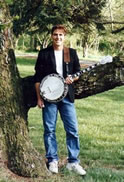SINGLE STRING TECHNIQUE PART ONE by Ross Nickerson

I would like to use this and next month’s column to discuss a part of five-string banjo playing that often gets overlooked, single string technique. The single string style is being incorporated more and more into contemporary banjo playing and it can add so much to your own style, sound, and versatility. Single string playing has often been referred to as Reno or sometimes Adcock Style. Both Reno and Adcock used single string picking mixed in with a more traditional three-finger style. At that time it was more unique, they were developing and playing this style at a time when there were not many players doing that. Now, most agree that single string style can be something that all banjo players can benefit from and find very useful in many playing situations.
If you have a more traditional approach and consider yourself a more Scruggs’ Style player you can use many single string techniques to add punch to your playing. For instance, playing a two note alternating thumb and index on the same string. As a simple example, substituting a 2nd fret 4th string to open 4th string pull-off, to picking both notes with the thumb index on the same string.In melodic playing the single string technique can be the best way to get a note you need in the melody and sometimes the only way to get it. Sometimes the tone you get with single string technique will add variety to the repetitive flowing scales of melodic playing.
Taking extended solos in the single string solo can take a lot of practice. For most banjo players the left hand has been considered secondary to the demands and importance of your right hand picking. To have your priorities straight it does make sense to start with the right hand but it also makes sense to maximize your capabilities and have this valuable technique ready to implement when it suits the song you’re playing the best.
In the context of performing, the single string technique is very flashy and will often be rewarded with applause. To the audience it looks harder. It’s hard for them to see the intricacy of the right hand when you’re banging out Foggy Mountain Breakdown. However, it’s much easier for the audience to see the intricacy of a flat-picking guitar solo for instance, which can explain why flat-picking can be so impressive to watch, and commonly receives applause. Wouldn’t it be nice to lay down some single string solos of your own in addition to your hard driving right hand?
In next months column I will include tablature and instruction with some specific examples and applications. These will include integrating single string technique into Scruggs’ style, melodic style, along with exercises, and a full solo.
In the meantime here are some recommendations for practice. If you are at a more beginning level, you could start by playing scales using an open string between each note within the first five frets. If you are more intermediate or advanced, you could practice scale patterns. I recommend that you take each one separately, use a metronome and keep increasing your speed. In order to play these scales or patterns at a reasonably fast tempo you will have to commit them to muscle memory and have them be as automatic as your right hand rolls are. Don’t forget just how much time you put into your right hand practicing and be patient as you work up your ability. Another quick tip is to keep your fingers close to the neck as you are playing these scales. You wouldn’t want to lift your right hand fingers far from the strings when you’re picking, would you? Excess finger movement in either hand will slow you down and could make you sloppy. I have a book with two cd’s called How to Build Your Speed on the Banjo available at my website rossnickerson.com that covers many of these issues
If you haven’t put the time into your left hand technique that you feel you should have up until now, this may be a good time to make up for it. I believe it can open more musical doors for you and add to your banjo playing experience.
Ross Nickerson’s main teaching website

Banjoteacher.com
